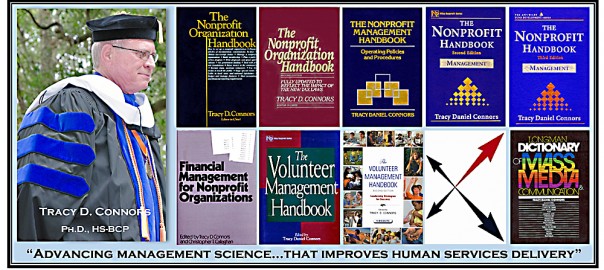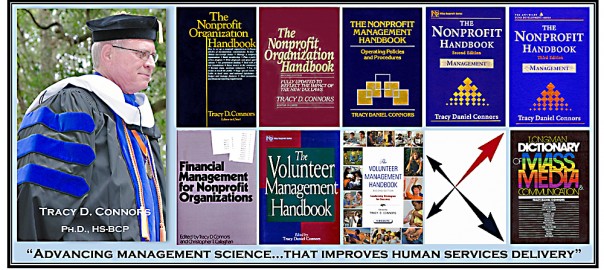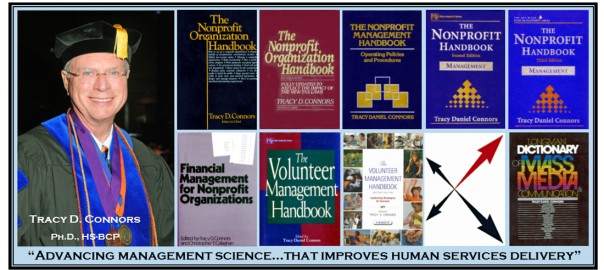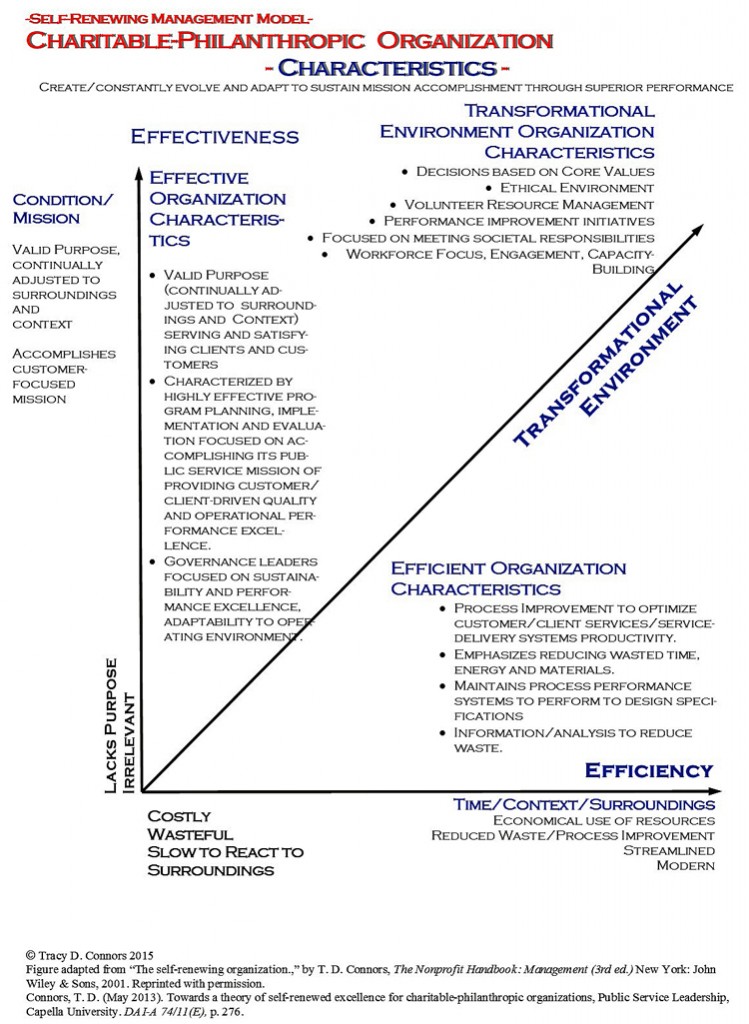The Way Ahead: Resolving False Dilemma by Achieving Excellence
by Dr. Tracy D. Connors
Journalists, commentators, and even some researchers, tend to view national pressures on charities to improve Effectiveness, Efficiency, Accountability and Transparency (E/EAT), through the perspective of “them” versus “us.” Instead, a better understanding of this artificial polarity can be achieved by viewing the growing national mandates as “game changing,” prioritized strengthenings of several traditional core values within North American society. Simply stated, the polarity of views contrasts societal values for highly economical (cost-effective) allocation and expenditures of public funds and charitable donations, with charitable values placing higher value on public and human services missions. Overlooking a broader, values-based perspective, one incorporating the many commonalities between sectors, has led to a false dilemma perception for many charities of being forced to choose between societal values (“bang for the buck”) versus traditional charitable values (caring and doing good).
Hurwit & Associates (2011) pointed out that accountability and transparency are now expected by funding organizations and donors and that have what the authors term “savvier consumers.” Most public and private sector donors and revenue sources expect and demand more for their charitable dollar. Individual donors increasingly want more accountability, control, or even active participation in how their charitable dollars are put to use. Significantly, more funding agencies, e.g., foundations and corporations, are requiring detailed financial reports, and reports outlining program results and benefits.
We can expect to see more program evaluation, Carman (2007-2009) predicted, more performance measures, more outcomes and results assessments , and greater use of planning and evaluation approaches such as logic models. We can also expect to see more extensive external monitoring from government agencies, coupled with a greater focus on programs demonstrating results as defined by the funder. Consequently, many nonprofits will need to reevaluate the way they make operating and programming decisions, reflecting the influence of funding decisions made by donor and funder organizations that she suggests will tend to reward those organizations seen to be making better use of evaluation and performance information (continuous process improvement) in their efforts to improve human services delivery (Carman, 2007-2009).
Continued funding cuts, King (2010) suggests, put some nonprofit organizations in jeopardy of having to close down or merge with another. What King may overlook or fail to consider is the considerable contribution toward organizational sustainability and survival made by a balanced financial management strategy, one that adopts as a priority establishing – and sustaining – a robust, broad-based, and multifaceted, revenue generating program. Nonprofits that eschew the rigors of an ongoing and multifaceted resource development program may find their original missions compromised by pressures to adjust the organization’s focus (“mission creep”) to meet the demands or inducements of a grantor or funding organization. Further, should the funding source fail to deliver the needed revenue, the nonprofit may indeed be facing a highly problematic and uncertain future.
Nationwide, nearly 33,000 human services providers administered 200,000 government contracts and grants in 2009. Those funding sources are vital to human services needed by millions of Americans, and important to the nonprofits who provide those services based on those funds. A recent study by the Urban Institute – the National Study of Nonprofit-Government Contracting, State Profiles, illustrates the dangers for nonprofits of putting too many financial “eggs,” into the public funding basket. Key problems facing nonprofits were identified in this study, including: late payments, changes to contracts, complexity of application and reporting requirements, and insufficient payments. Whether large or small, well over half of all nonprofits experience problems with their publicly funded human services contracts and grants (Boris, de Leon, Roeger & Nikolova, 2010).
Clearly, E/EAT pressures are likely to continue over time as “society” continues to assert primacy for the “economy” core value. In any values conflict between society, and an organization such as a public charity allowed to operate within its physical or economic borders, society can be expected to ultimately prevail. There are fundamentally two courses of action open to America’s charities: wait to be forced into various modes of compliance based on external pressures, e.g., regulations guidelines or requirements; or, opt for self-directed, values-driven, internal compliance, i.e., identifying and prioritizing organizational humanistic values supporting E/EAT, while retaining essential organizational ethos. Fortunately, those charities opting for a pro-active, values-driven E/EAT strategy can also preserve their ethos, and add to their sustainability through improved financial and performance management.
Conclusions and Summary
Governance leaders of America’s charitable organizations face significant pressures to achieve greater effectiveness, efficiency, accountability, and transparency (E/EAT), much of it based on growing public perceptions and skepticism created by biased mass media coverage . Conflicting, confusing news and dialogue, typically polarized between calls for reform and innovation (controversy and conflict), versus alarmist threats to traditional charitable values, can best be understood as a values-driven debate characterized by Berger, Penna and Goldberg (2010) as the “battle for the soul of the nonprofit sector” (p. 1). Unbalanced, superficial news coverage of the nonprofit sector is also seen as cuing the public to support more regulation and law.
Growing pressures on nonprofits to be more “businesslike,” can be seen as pressures to strengthen several traditional national core values, e.g., economy. However, commercialism is seen as dangerous by such sector leaders as Pablo Eisenberg, threatening such traditional charitable core values. Others, such as Sanders (2008), suggest the dialogue should change from dialectic and oppositional (a false dichotomy), to embrace the benefits to charitable mission fulfillment and ethos offered by integrating both business models. New, hybrid business-nonprofit business models are steadily expanding the operational and resource generation options available to nonprofits, and do not necessarily require abandoning traditional charitable values.
Nonprofits that decide to pursue excellence can resolve potential conflict, fulfill their societal social contracts, and retain their essential ethos, by adapting and using those business models and strategies from both sectors that offer results achieving both economy and caring during the pursuit of sustained superior organizational performance. For most nonprofits, the way ahead should include adopting an individualized, values-focused strategy for excellence, one that also ensures sustained effectiveness, efficiency, public accountability, and operational transparency.
References:
Berger, K., Penna, R. M., & Goldberg, S. H. (2010, May 25). The battle for the soul of the nonprofit sector. In Philadelphia Social Innovations Journal (Issue 3) [Http://www.kenscommentary.org/2010/05/battle-for-soul-of-nonprofit-sector.html]. (Regional on-line journal.). Philadelphia Social Innovations Journal.
Boris, E. T., De Leon, E., Roeger, K. L., & Nikolova, M. (2010, October). National study of nonprofit-government contracting [Http://www.urban.org/uploadedpdf/412227-National-Study-of-Nonprofit-Government.pdf]. On-line report). Urban Institute.
Carman, J. G. (2007-2009, March). Evaluation practice among community-based organizations. American Journal of Evaluation, 28(1), 60-75. doi: 10.1177/1098214006296245
Hurwit & Associates. (2011). Nonprofit trends, tax exemption, lobbying, governance, liability [Web page]. In Nonprofit law resource library. Retrieved April 15, 2011, from Hurwit & Associates: http://www.hurwitassociates.com/l_21_trends.php
King, D. (2010, April 19). Three significant trends in nonprofit financial management [Web page]. Retrieved April 15, 2011, from Examiner.com (Corpus Christi, TX): http://www.examiner.com/nonprofit-business-in-corpus-christi/three-significant-trends-nonprofit-financial-management
Sanders, M. (2009). Business-like or charitable? communication and irrationality in a nonprofit organization. (Doctoral dissertation, University of Colorado at Boulder, 2008). DAI-A 69/07. Retrieved from http://search.proquest.com/docview/230671126?accountid=27965
Suggested Citation:
Connors, T. D. (2016, February 22). Resolving False Dilemma by Achieving Excellence [Overlooking a broader, values-based perspective, one incorporating the many commonalities between sectors, has led to a false dilemma perception for many charities of being forced to choose between societal values (“bang for the buck”) versus traditional charitable values (caring and doing good).]. Retrieved from NPO Crossroads: http://www.npocrossroads.com/effectiveness/resolving-false-dilemma-by-achieving-excellence/




